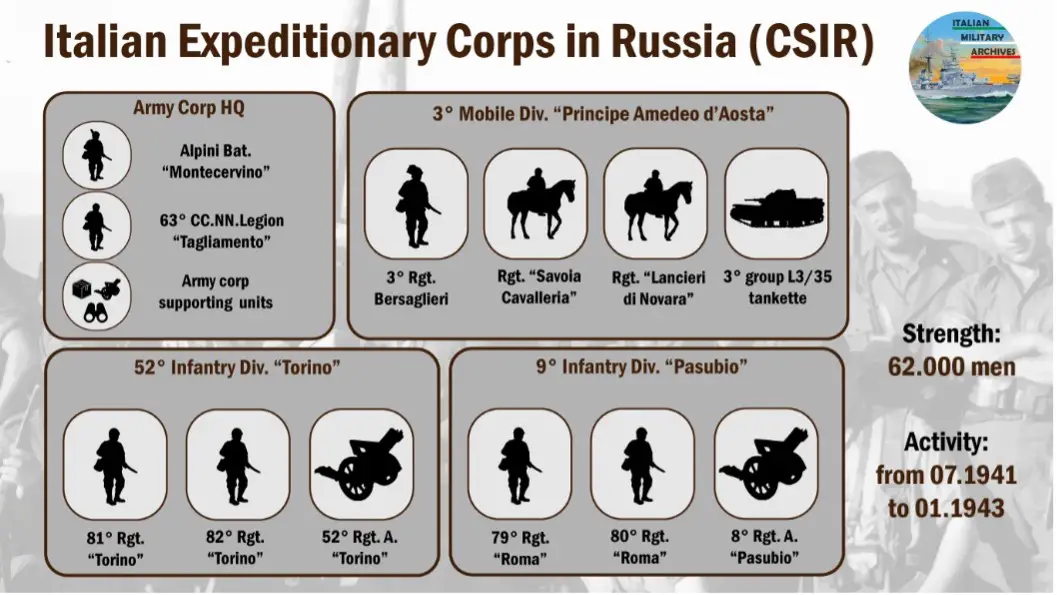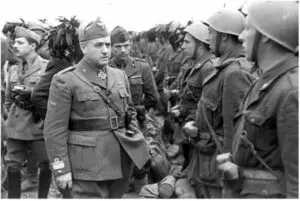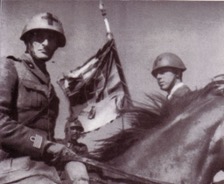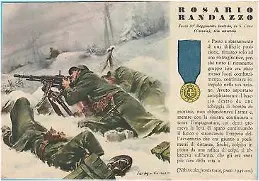Operation Barbarossa and the CSIR
In June 1941, Benito Mussolini was well aware that a war between Soviet Russia and Nazi Germany was imminent and when he was wakened up on the night of the 22nd of June to receive the letter from Hitler announcing the invasion he was not surprised. By then, the idea of the Italian “parallel war” had already failed in the sands of North Africa and on the Greek mountains. Nevertheless, and in sharp contrast with the reality, Mussolini continued to seek ways to counterweight the prominence of Germany within the Axis pact and saw the need to send Italian troops on the Eastern front, a mere political move. After a first denial, Hitler finally accepted the Italian support and the new expeditionary (army) corps began to assemble. Its official name was “Corpo di Spedizione Italiano in Russia” (CSIR).
It was constituted by the 3rd Division “Principe Amedeo d’Aosta”, made by mobile units like Bersaglieri, Cavalry and tankettes. Then the infantry divisions “Torino” and Pasubio”, the Alpini Batallion “Montecervino” (Mountain troops), the Blackshirts Legion (roughly 2000 men) “Tagliamento” and various supporting units (Detailed OOB).


Giovanni Messe with the Bersaglieri
General Francesco Zingales was chosen to lead the corps and soon he realized that transports and tanks were not available in sufficient numbers. He issued a request to Mussolini for additional tanks but, allegedly the Duce replied that from now on, he could only request medals for his men, another episode denoting the scarce military skills of the Dictator. However, Zingales soon fell ill and a replacement had to be found. The choice fell on General Giovanni Messe, a man who had distinguished himself in the Greco-Italian war and perhaps the best General Italy had in WW2.
A total of 225 trains were used to transport the CSIR to Borșa, on the Romanian-Hungarian border, the first units arrived already on the 13th of July. From here, the Italian divisions had to reach the frontline (300 km) with their means. However, the rapid German advance and the lack of sufficient transportation meant that they were always on the move, trying to catch up with the forward-moving frontline.
First operations and logistics

Men of the Savoia cavalry regiment
The CSIR was put under the command of General Von Kleist (Panzergruppe Kleist) and the baptism of fire finally arrived in the first weeks of August 1941. Von Kleist’s army had penetrated the Soviet defences In Ukraine near the river Bug, while the Italians formed part of its left wing. The task assigned to the CSIR was to link up north with the Germans and cut the retreat to the soviets.
On the 11th of August, elements of the Pasubio division clashed with the Soviets and covered 400 km in 4 days, winning their first victories on the Eastern front. After the battle on the river Bug, General Messe realized the dire conditions of the logistics on the Eastern front and registered the decrease in the supplies (mostly in charge to the Germans) and the insufficient equipment of his men. He decided to act on his own and organized his logistical chain in Romania, heavily relying on the black market, where his command purchased horses, supplies and winter clothes for his men (predicting a not fast conclusion of the campaign).
In September, the entire CSIR was gathered on the Dnepr river (In Ukraine) covering the right flank of the German 11th Army. For eight days, the CSIR was involved in the heavy fights that occurred on the Dnepr and on the 30th the Soviet defences collapsed, leaving tons of supplies and thousands of prisoners behind. In October and November, the CSIR was involved in the fights in Eastern Ukraine, as the battles of Petrikowka and Stalino, General Messe wisely used his mobile column and was always able to overrun the enemy. During these fights, also the Cavalry regiments “Savoia” and “Novara” were deployed to repel soviet counterattacks, with their men charging on horses.
Battle of Nikitovka

Article commemorating Randazzo’s action (1941)
In early November, the 80° regiment of the Pasubio division had ventured to the extreme left of the CSIR and found out that strong Soviet forces were dangerously in between the German forces to the left and the CSIR. The regiment commander, Colonel Epifanio Chiaramonti decided to occupy the village of Nikitowka to prevent the Soviets from manoeuvring in between the axis armies. The regiment soon faced elements of three soviet divisions that surrounded Nikitowka.
For six days, Chiaramonti’s men repelled enemy attacks, running dangerously close to the exhaustion of all ammunition. During the battle, 21-year-old machine gunner Rosario Randazzo lost his right arm to a grenade explosion, he continued to fire his machine gun handling it with his left arm and pushing the firing mechanism with his teeth. He died slightly afterwards and was awarded the gold medal for military valour. On the 13th November, after some initial failures, reinforcements from the other CSIR divisions managed to break the encirclement, relieving the 80° regiment. At this point, the Soviets withdrew.
On the defence
With the Russian winter in full swing, the axis advance halted and the CSIR set up defensive positions in Ukraine. In December, the Soviets went on the offensive and the CSIR divisions were involved in the heavy fights, not losing ground to the Soviets. This series of confused and spread clashes is known to the Italians as the “Battaglia di Natale” (Christmas battle) and ended up in the halt of the Soviets assaults. From January to March 1942, the CSIR saw little action and spent time recovering from the heavy fights and long marches of the previous months. In summer, prospects for a renewed German offensive led Mussolini to strengthen the Italian presence on the Eastern front by sending fresh units. The Italian forces were re-organized in the 8th Army or “Armata Italiana in Russia” (ARMIR) and the CSIR was renamed XXXV army corps.
Sources
Jowett, P. (2019). L’esercito italiano nella seconda guerra mondiale. LEG edizioni.
Petacco, A. (1998). L’ Armata scomparsa. l’avventura degli Italiani in Russia. Mondadori.